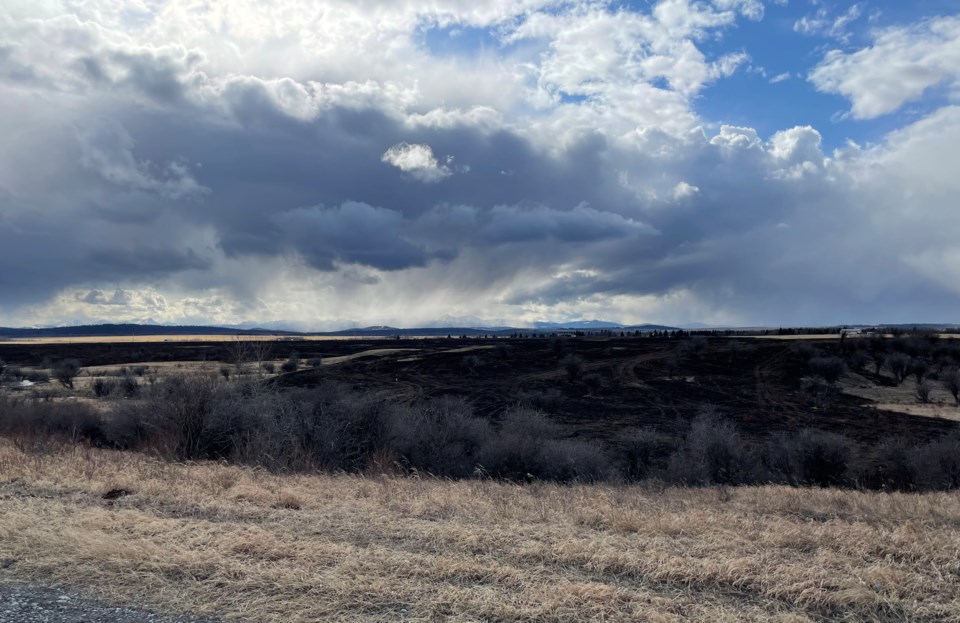Yelling the word “Fire” to a rancher is like yelling “Bomb” in a busy airport. It sends shivers up one’s spine.
Those same shivers came over me when I received a call March 31 there was a fire burning out of control just east of our ranch. When events like this occur, we were grateful the nearby Redwood Meadows Emergency Department was on their way.
However, it was the neighbouring ranchers and farmers who made a world of difference fighting the fire. Peter Hughes is one such rancher. I’m writing this because I know he, like the ranchers I grew up with, will not ‘toot their own horns’, as the old saying goes. They are humble to the core. But he needs to know his crew made a difference that March 31 afternoon and how thankful we are.
The fire started innocently enough. New acreage owners were burning garbage in a burn barrel. But what they didn’t know because they are new to country living is that it was much too dry and windy to be burning.
I know they feel terrible after talking with them. And I jokingly said that their real estate contract needed to have a fire clause in it about the dangers of burning in the country. I imagine they will be paying a hefty fine from the County for their actions.
From the huge plumes of smoke that afternoon, you could tell the wind was pushing the fire out of control. It was heading straight east along the north side of Highway 8 – directly in line to multiple farms, acreage owners, River Spirit Golf Course and the hundreds of million-dollar homes in the Elbow Valley subdivision.
Hughes had a vested interest in fighting the fire that day. He rents the land along Highway 8 for his cattle, and subsequently stores his hay at the site. Worth thousands of dollars, it could have gone up in smoke in an instant.
His cows were also nearby, only weeks away from calving. Another farmer in the area has hundreds of thousands of dollars’ worth of farming equipment. Our ranch was only a few kilometres west of where the fire was happening.
I guess it’s safe to say the team of neighbours who gathered that day all had a vested interest in fighting the fire. We quickly brought full water tanks and bulk totes, trucks, tractors, and shovels to help put it out. But it was thanks to Peter, his son Cole, and Alastair Spark, who all stayed until 2 a.m. on April 1.
They stayed because they wanted to ensure the fire was out. As Peter’s wife Laurie said: “they had to keep wetting the hot spots, the flaming cow patties, and the old dead willows when the wind changed.”
I’m deathly afraid of fire. Maybe it is because I remember the feeling of dread I would have when my father would leave in a hurry after getting a call that a neighbour’s field was ablaze. The usual culprit was because someone had carelessly and thoughtlessly thrown out a cigarette butt while driving down the highway.
Maybe my phobia is because I remember the stories my grandmother told of how afraid they all were when the November 1936 fire struck at Sibbald Flats. There was even a designated “fire” ring to the phone lines at the time.
The event is well documented in the Chaps and Chinooks history book – the fire of 1936 burned 100,000 acres to the east in the Cochrane and Jumping Pound area. It reads: “The muskegs and willow roots burned all winter and hayfields in the area looked as if there were little candles burning as the stubble continued to burn. They burned until the rains of the following June.”
Maybe my fear of flames is because I had another out-of-control grassfire heading toward my home when my family lived in Colorado. The 2013 Black Forest fire covered 22 square miles (57 square kilometres), 14,000 acres (5,665 hectares), burned 509 homes and killed two people. I took photos around the house quietly, as to not scare my children should we be evacuated. Luckily our home was spared.
My son’s best friends’ home was not. Or maybe it’s because recently I had been back in the Colorado area when the Marshall Fire struck on Dec. 30, 2021. High winds clocked in at 185 km/h and the extent of the fire was an estimated 6,200 acres (2,500 hectares). In only a matter of hours, 1,084 structures, including houses, a hotel and at least one shopping center, had burned. In terms of structures lost, it was the most destructive fire in Colorado’s history.
We all need to learn from those lessons of loss that others have suffered. Fire affects everyone when it rages out of control. I’m thankful to the Redwood Meadows, Elbow Valley, Springbank, and Langdon emergency crews for showing up, to Peter, Alastair, and Cole for staying until the last spark was out, and to all the neighbours for their firefighting efforts. If I’ve forgotten anyone, please forgive me.
You are more than welcome to move to a rural setting. However, when you do, please know the rules about fire. And please know that you are moving into a community of neighbouring farmers and ranchers who have the tools necessary and will drop what they are doing in an instant to help when called upon. Everyone’s efforts that afternoon may have just saved hundreds of homes and possibly lives from a potentially devastating fire. We just pray there isn’t a next time. But we’ll be there if there is.
Tracey Feist is a freelance writer who lives west of Calgary, in Rocky View County.



